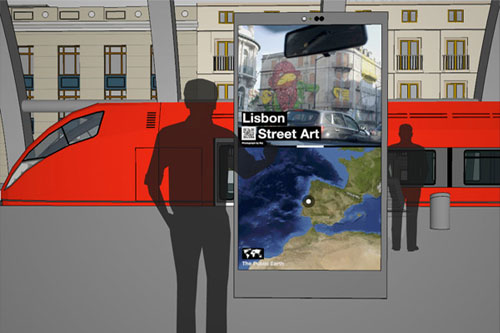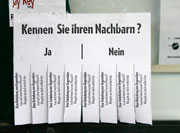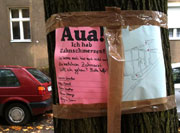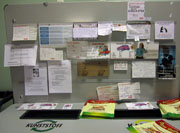What should be done with large displays in the public and semi-public sphere?
Within the last couple of years large interactive displays have been massively installed in public and semi public spaces. However, sustainable concepts and ideas of how to use this technology for the public good are still widely missing. There must be more than advertising and the weather!
With the advent of the smartphone (for all!) hence the ubiquity of location aware technology, internet access and the expanding social media network, a great number of new applications and services are expected to pop up in the near future. The research and design class Public Displays. Und Jetzt? (And Now?) looked carefully at these infrastructural phenomena. We analysed existing solutions in regards to usefulness, community acceptance and social compatibility. Based on the analysis new design concepts and future scenarios that go beyond the Status Quo were developed. We aimed at creating future applications that use new technology in creative ways, that are desirable, non-commercial, socially sustainable and community supportive and just »make sense« to us, when you keep in mind the Public Space is there for the public.
The class took place during the winter semester 2011/12 at the Potsdam University of Applied Sciences, as part of the Interfacedesign program, supervised by Monika Hoinkis.
Internal Workspace

View documentation
The project connects a public display with a smartphone of a passing pedestrian. People are invited to draw their own flower with a provided web-app accessible via QR Code.
Furthermore, it is possible to interacte with the installation through body movement.
The aim of the project is to slow-down the passing people by enabling interaction and visualization of something interesting and beautiful on a public display instead of showing commercial content.
The project was realized in HTML5 with the support of the JavaScript 3D library three.js and Microsoft Kinect.
View documentation
(Dr. M. V. Giuliani, 2003)
How far can personal experiences and stories help to strengthen the connection to a place? Within a series of experiments and prototypes we investigate adequate methods for collecting personal stories in a public context. Furthermore we develop an on-spot installation presenting the collected stories to foster the attachment to place. During the process we explore to what extent analog as well as digital ways can be used to collect and display personal stories.
We are working on a crosspoint of three Berlin boroughs Prenzlauer Berg, Mitte and Friedrichshain: in between old and new buildings, natives and new arrivals, proletariat and gated community. A place where many opposites can cause friction.
View documentation
View documentation
How could public displays draw attention to human rights organizations and people encourage to join their interests? This project inspects the theory that a direct interaction of a single person in a public debate is working better when it’s placed visible to others in the public space. The observer gets involved in a real case and receives the possibility to deal with this. After joining the debate via a mobile website the observer receives a positive feedback in interactive form shown on the public display right on front of him.
View documentation
Using a public display with a tracking device like Microsoft Kinect, a person can stroll around in a virtual representation of the distant place (Google StreetView in our case), using their body as a controller. Turning and tilting their body lets them look around, while they can move by jumping or walking in place. The physical interaction makes the strolling feel more real.
Remote Strolling could be deployed in public spaces or museums, letting visitors walk around the archaeological sites artefacts were found at, having a stroll around a historical version of the city they’re in, or calling attention to partner cities.
For an even more genuine strolling experience, the location’s current weather is represented as well. For historical sites, the current weather could be used as well, to strengthen the emotional bond. To encourage strollers to explore the area, additional information can be shown: a compass display pointing strollers in the direction of points of interest; explanatory overlays for them; and hyperlocal news tied to specific places.
View documentation
Situated constructs a pattern from the user’s long-term movements. It tracks locations and respective movement velocities. The resulting map illustrates where the user is frequently commuting without ever stopping by and exploring afoot. Along these routes, the user is provided with suggestions for places to visit. Upon arrival, he is invited to make a certain contribution to the place. Among the possible invitations are directions to take pictures of certain things, descriptions of the place, choose songs from the user’s music library to listen to and describing aspects of the music. A contribution unlocks the place’s »secret«. The user has now access to all consistent contributions to the place. Selected contributions can be broadcasted anonymously on public transport that is passing the according places.
View documentation






























